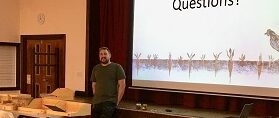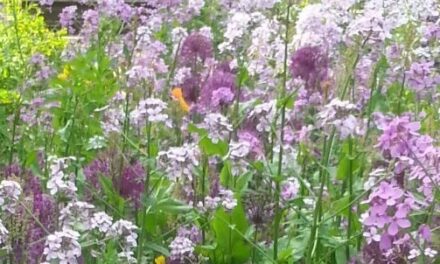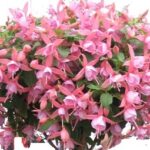Meeting: November 26th
On 26th November, Roger Umpelby gave a talk to the club about soil and plant nutrition. Roger listed the main features of soil that interest a gardener as texture, organic humus content (which allows plants to take up minerals), the pH level and the macro & micro nutrients.
We learned that soil particles are categorized into three groups by size – sand, silt, and clay, with sand being the largest and clay the smallest. The relative percentages of sand, silt, and clay are what give soil its texture. Loam is a mixture of all three; the percentages for loam vary but ideally are 40% sand, 40% silt, 20% clay.
Roger explained that adding organic matter helps to bind soil together, retains moisture, replaces plant nutrients, makes heavy soil workable and helps sandy soil to be more moisture retentive. There may be good reasons for tidying up the garden (e.g. to prevent proliferation of disease or to stop the spread of weeds) but this does disrupt the natural process of organic matter returning to the soil. Organic matter degrades over time and cultivation speeds up this process, so gardeners need to introduce additional matter on a regular basis. There are a number of sources of organic matter available to the gardener such as well rotted farm yard manure and municipal compost. Roger showed us a photograph of his own homemade compost which was fairly coarse. He explained that the benefits to the soil of coarse compost can last up to 3 years because the larger elements decompose over time, whereas the benefits of finer organic matter are short lived, only lasting for up to 6 months. His recommendation was to use 5-10kg/m2 when digging in organic matter or a depth of 8cm when spread as a mulch.
Roger explained that the pH level of soil is important because it affects the availability of nutrients to plants. For example phosphorus can be most readily taken up by plants where there is a pH of 6.4 to 7.5 but iron take-up requires a pH of 4.8 to 6.0 and potassium requires 6.0 to 9.0. The soil pH of your garden may be completely different to the pH of your tap water. However, it is best practice to use rainwater where possible for watering plants, particularly for acid loving plants.
In order to understand what type of soil you have, there are pH testing kits readily available from garden centres and online. Roger recommended testing once or twice a year. There are also laboratory services available which will undertake further analysis of the soil. The RHS offer one for £35 (£30 for members).
With regard feeding of plants, Roger’s main message was to avoid over feeding at all costs. He said that he mostly used an organic seaweed based feed which provided the main 3 plant nutrients (nitrogen, potassium and phosphorus) but also contained many trace elements (nutrients that plants only need small amounts of) which are often lacking in other products. He showed us photographs of a vast array of different products available on the market but his recommendation was to use a general purpose feed unless specialising in growing large numbers of one particular type of plant.
Jane Cross








